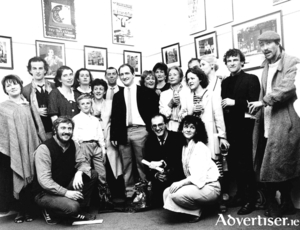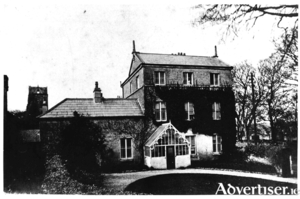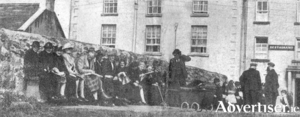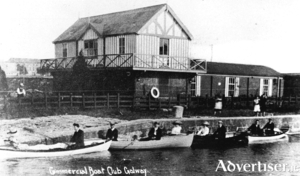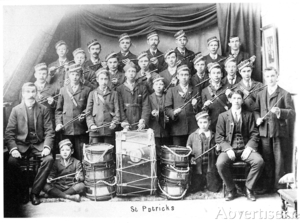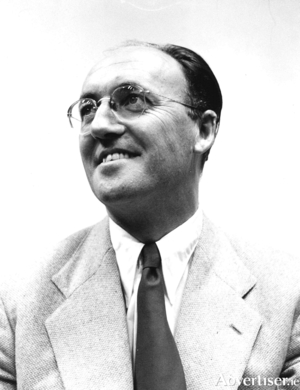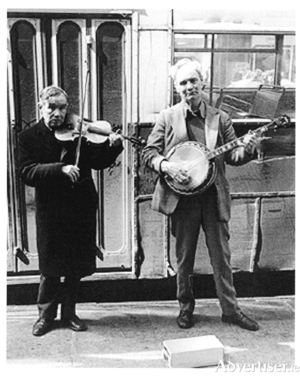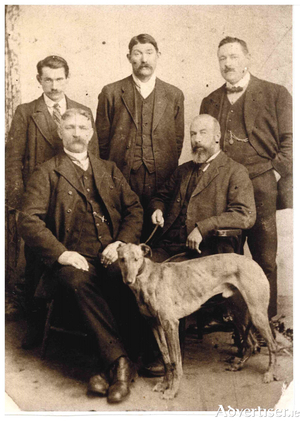The KLM disaster
Thu, Aug 14, 2025
On this day, the 14th of August in 1958, the Dutch KLM Super-constellation airliner named Hugo de Groot crashed into the sea about 100 miles off the Conamara coast with the loss of 99 lives. The flight was on its way to New York from Amsterdam via Shannon with 91 passengers and eight crew on board. Nobody survived the tragedy. It was the worst disaster involving a single plane in the history of aviation up to that point.
Read more ...Nimmo’s Pier and 'The Swamp’
Thu, Aug 07, 2025
In 1822, the harbour of Galway was very defective with only one small dock, now known as ‘the mud dock’, and two small jetties on the Claddagh shore. The outflow of the river was too great to allow sailing boats to enter safely at low tide. They had to wait outside on the roads for high tide, and even then, the entry could be tricky when the wind was strong. The merchants of Galway petitioned the Lord Lieutenant in 1820 to make improvements and he forwarded their request to Nimmo.
Read more ...The Galway Races
Thu, Jul 31, 2025
Records of organised race meetings in County Galway go back to the mid-13th century when what were known as ‘horse matches’ were run under the King’s Plate Articles. In 1764, there was a five-day race meeting at Knockbarron near Loughrea. The first race day at Ballybrit was on August 17th, 1869 when contemporary records show that some 40,000 people turned up to watch the sport. The racecourse, measuring one and a half miles, was laid out by a civil engineer, a Mr. T. Waters and was described as “Covered with herbage or moss and excelling any course in Ireland for good going”.
Read more ...One hundred years of golf at Blackrock/Pollnarooma
Thu, Jul 24, 2025
In December 1923, the committee of Galway Golf club, then based at Barna, decided to explore the idea of acquiring the late Col O’Hara’s estate at Blackrock and on April 24, 1924, they bought the West Lodge and the land at Pollnarooma for £4,750 plus £237 auctioneer’s fees. Messrs Tighe, Kennedy, Lenihan and Quinlan were appointed to oversee the laying out of the new course and the renovation of West Lodge which had been Col O’Hara’s house.
Read more ...Galway Golf Club, the Barna course
Thu, Jul 17, 2025
On May 9, 1905, there was a meeting held in the Royal Hotel of golfers that had been banned from membership of the Gentian Hill club by the landlord there, Sebastian Nolan. They decided to form a new club under the presidency of the Hon Robert Dillon. It was reported that on that day a committee had accompanied Larkin, the Bray professional, over a promising new course on Mr Marcus Lynch’s property at Barna and were happy about the suitability of the ground for a nine-hole links.
Read more ...The first Galway golf courses
Thu, Jul 10, 2025
The first golf course in Galway was constructed by Lieutenant Colonel Jourdain, the last Colonel of the Connaught Rangers, on military grounds at Renmore Barracks, between the rifle range and Cromwell’s Fort, in 1893. Play was originally confined to military personnel, but then some members of the public were invited and it took off so well that the colonel and his friends were invited to lay out a course on Knocknacarra Hill.
Read more ...Celebrating 50 years Of Druid
Thu, Jul 03, 2025
On this day, 50 years ago, Druid Theatre Company opened their first production, ‘The Playboy of the Western World’ in the Jesuit Hall on Sea Road. The following evening they staged “It’s a two foot six inches above the Ground World” and on the third night it was “The Loves of Cass Maguire”. It was an ambitious beginning.
Read more ...Celebrating 50 years of Druid
Wed, Jul 02, 2025
On this day, 50 years ago, Druid Theatre Company opened their first production, ‘The Playboy of the Western World’ in the Jesuit Hall on Sea Road. The following evening they staged “It’s a two foot six inches above the Ground World” and on the third night it was “The Loves of Cass Maguire”. It was an ambitious beginning.
Read more ...Spires House and Fort Eyre, Shantalla
Thu, Jun 26, 2025
On this day, June 26, one hundred years ago, the Sisters of Jesus and Mary bought Spires House in Shantalla. Three of the sisters in the order had come to UCG the previous year to study for a degree and while they were in Galway, Mother Stanislaus looked for a suitable premises for a house of studies for them and finally purchased this premises. The house dates from the 1840s and got its name from the two unusual spires you can see on the roof. The building was used by the sisters as a hostel for secular students as well as their own nuns and these nuns became known locally as ‘The Spires Nuns’.
Read more ...The Lazy Wall
Thu, Jun 19, 2025
The Lazy Wall was a feature of life in old Salthill. It was situated opposite the Grand Hotel and beside the old RIC barracks. It would be roughly where the west-bound lane opposite where the BonBon is today. It consisted of a long concrete seat, boarded on top, backed by a stone wall. It was not very comfortable but it attracted lots of people, mostly tourists, most of whom were country people.
Read more ...The fishermen of the Claddagh, 1853
Thu, Jun 12, 2025
An important ethnological study of the fishermen of the Claddagh appeared in the Ulster Journal of Archaeology in 1853, written by someone who signed themselves J McE. In it, the author describes the people of the area as being purely Irish, of the most ancient Celtic type. There is no Spanish influence to be seen in their features.
Read more ...The oldest pub golfing society in Ireland
Thu, Jun 05, 2025
In 1965, the Galway Arms Golf Society was formed in the pub of that name on Dominick Street with the blessing of the owners, Jimmy and Nancy Coen. The idea of forming a society was Tommy Donnelly’s who, for his troubles, became its first secretary. Jimmy Coen was elected the first president, Finbarr O’Mahony as treasurer and Paddy Noonan as club captain.
Read more ...Pat O’Shea
Thu, May 29, 2025
Catherine Patricia Shiels O’Shea was born on January 22, 1931, the youngest of five children, known locally as Patty Shiels. Her father Patrick was a carpenter who built one of the first radios in Galway, her mother Bridget a homemaker. They lived in Bohermore. Her mother died when she was very young, leaving her elder sister Teresa to care for the siblings and their elderly father. Pat went to national school in the Presentation Convent and to secondary in the Mercy Convent.
Read more ...Galway Lawn Tennis and Croquet Club
Thu, May 22, 2025
One hundred and twenty five years ago this month, at a meeting in the Royal Hotel, a new and rather exclusive club was formed bearing the title ‘The Galway Lawn Tennis and Croquet Club’. Initially, it was proposed that they play tennis at Glenarde (where the Ardilaun Hotel is today) but that their stated intention was to acquire land specifically to lay it down for proper tennis and croquet.
Read more ...Commercial Boat Club, 150 years
Thu, May 15, 2025
As a result of a number of years planning by some enterprising young men, a meeting took place in the hall of the Mechanics Institute on this day, May 15 1875, one hundred and fifty years ago with the purpose of forming Galway Commercial Rowing Club. The resolution was formally proposed and seconded and unanimously adopted. The subscription was fixed at £1 which included the entrance fee and the annual sub. The following committee was elected – Laurence Carr, J St George Joyce, Morgan Lee, Thomas O’Gorman, Thomas Hogan, Thomas Hayes McCoy, Y Kean, James Maher, B Roche and Patrick Bodkin. In addition, 62 members enrolled.
Read more ...St Patrick’s Band, the early days
Thu, May 08, 2025
One of the most enduring of Galway's institutions is this band which has given pleasure to its own members and countless thousands of members of the public since it was formed in Forster Street in 1896. Thanks to dedicated leaders and teachers, this group of musicians continues to entertain. The founders were Peter Rabbitt, a Forster Street publican and grocer, Paddy Walsh, the station master and Michael Spelman of Moon’s staff.
Read more ...Walter Macken’s trilogy
Thu, May 01, 2025
On this Saturday, had he lived, Walter Macken would be 110 years old. He was born on May 3, 1915 in St Joseph’s Avenue. His father was originally from Knock, Spiddal and came to Galway aged 14 and worked as a carpenter during the day. At night, he became an actor who performed numerous roles in the Racquet Court Theatre in Middle Street. He became unemployed in 1915 and, as he had a wife and three children to support, he joined the British Army, the Royal Fusiliers to be precise. He was sent to France and was killed on March 28, 1916 in St Eloi. He is in our first photograph in his army uniform.
Read more ...Some Galway buskers
Thu, Apr 24, 2025
Busking is the practice of performing in public places, such as on the street, for tips or gratuities or voluntary donations. It comes from the Spanish word Buscar—to seek (fame and fortune) or the Latin word Buscare – to procure, to gain. Busking could take many forms, clowning, dancing, singing, fortune telling, mime, living statue, one-man band, puppeteering, juggling, reciting poetry, even Christmas carolling. One’s ‘pitch’, where one performed, was very important. It had to be a place where there was a lot of traffic, lots of people, high visibility and little background noise.
Read more ...Grealish’s Saddlery
Thu, Apr 17, 2025
Michael Grealish served his apprenticeship (it cost him 100 guineas) in Garret’s Saddlery in Eyre Square, roughly where the Imperial Hotel is today. When he finished, he decided to set up his own saddlery business at the beginning of the last century at Number 2, Eyre Square. At the time, the horse reigned supreme. There were regular horse fairs in Eyre Square at the time and this obviously helped his start-up.
Read more ...Kavanagh brothers
Thu, Apr 10, 2025
Seamus Kavanagh grew up in the village of Finod, near Easkey in Co Sligo. He went to the Technical School there and the principal suggested he apply for a position as a trainee electrician with T Naughton & Sons in Galway. His colleague at work, Paschal Spelman introduced him to the Order of Malta which became a life-long interest. He did a correspondence course and qualified as an electrician. Rural electrification brought about major changes in the home, and new electric appliances were in high demand, and Seamus found himself selling these and travelling throughout the county installing them.
Read more ...





